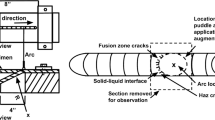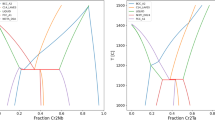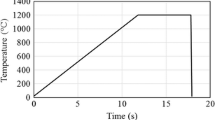Abstract
Ni-based filler metals for repair and construction of nuclear reactor components require 30 wt% Cr to insure resistance to primary water stress corrosion cracking (PWSCC). Current generation alloys can be susceptible to solidification cracking and ductility dip cracking, depending on Nb content and the amount of eutectic that forms during weld solidification. Computational thermodynamic modeling was used to identify alternative eutectic-forming elements to Nb, such as Hf and Ta. Previous work has utilized a design of experiment methodology (DOE) in conjunction with computational and experimental techniques to optimize a new filler metal composition that should be resistant to weld cracking. In this paper, the optimized compositions were subjected to further weldability testing, namely the cast pin tear test (CPTT) and the strain-to-fracture (STF) test. An optimized Ta-bearing composition was found to be crack resistant, while an optimized Hf-bearing composition was highly susceptible to solidification cracking. Differences may be related to the nature of the eutectic constituents that form at the end of solidification. The Hf-bearing composition did not form Laves phase as its final eutectic constituent, while Laves is present in both the Nb- and Ta-bearing systems.







Similar content being viewed by others
References
Andresen PL, Morra MM (2008) Stress corrosion cracking of stainless steels and nickel alloys in high-temperature water. Corrosion 64(1):15
Frederick G, Lu B, King C (2008) Technical basis for preemptive weld overlays for alloy 82/182 butt welds in PWRs. (EPRI, 2008)
Fredette L, Scott P (2010) Evaluation of full structural and optimized weld overlays as mitigation strategies for primary water stress corrosion cracking in pressurized water reactors. (Battelle, 2010)
Jacko RJ, Gold RE, Kroes A (2003) Accelerated corrosion testing of alloy 52M and alloy 182 weldments. 11th Int. Conf. Environmental Degradation of Materials in Nuclear Systems
Kiser SD, Hinshaw EB (2005) Nickel alloy welding requirements for nuclear service. Focus on Nuclear Power Generation, pp 21–26
Lippold JC, Nissley NE (2008) Ductility-Dip cracking in high chromium, Ni-base filler metals. Hot Cracking Phenomena in Welds II, pp 409–425
Alexandrov BT et al (2011) Weldability studies of high-Cr, Ni-base filler metals for power generation applications. Weld World 55(3–4):65
Cieslak MJ (1991) The welding and solidification metallurgy of alloy 625. Weld J 70(2):S49–S56
Dupont JN, Robino CV, Marder AR (1998) Solidification and weldability of Nb-bearing superalloys. Weld J 77(10):417s–431s
Przybylowicz E. et al. (2016) Weldability evaluation of high chromium, Ni-base filler metals using the cast pin tear test. In: Cracking phenomena in welds IV. Springer, pp 269–288
Baeslack WA III (1988) Weld cracking in Ta-modified cast Inconel 718. Scr Metall 22(5):729
Kotval PS, Venables JD, Calder RW (1972) The role of hafnium in modifying the microstructure of cast nickel-base superalloys. Metallurgical Transactions 3(2):457
Dahl JM, Danesi WF, Dunn RG (1973) Partitioning of refractory metal elements in hafnium-modified cast nickel-base superalloys. Metallurgical Transactions 4(4):1087–1096
Dmitrieva GP, Shurin AK (1974) Investigation of phase equilibria and structure in Ni-ZrC and Ni-HfC alloys. Metallofizika 53:97–100
Nash P, West DRF (1981) Phase-equilibria in Ni-rich region of Ni-Cr-Hf system. Metal Science 15(8):353–356
Fusner E, Hope A, Lippold J 2014 Development of high-Cr, Ni-based filler metals using combined computational and experimental techniques. Weld J 93(5)
Nissley N (2002) Development of the strain-to-fracture test for evaluating ductility-dip cracking in austenitic stainless steels and Ni-base alloys. Welding in the World 46(7–8):32
Luskin T, Alexandrov BT (2012) Improvement and modeling of the cast pin tear test. AWS Professional Program, Las Vegas
Luskin TC (2013) Investigation of weldability in high-Cr Ni-base filler metals. The Ohio State University
Kreuter VC (2015) Optimization and application of the strain-to-fracture test for studying ductility-dip cracking in Ni-base alloys. The Ohio State University
Sowards JW (2009) Development of a chromium-free consumable for joining stainless steel. The Ohio State University
Feng X, Hope A, Lippold JC (2014) Effect of Cr on eutectic phase formation and solidification temperature range in Ni–Cr–Hf system. Mater Lett 116:79–81
Acknowledgements
This work was supported by the Electric Power Research Institute (EPRI) in Charlotte, NC. Special thanks to program Manager Steve McCracken for his insight and encouragement throughout the project.
Author information
Authors and Affiliations
Corresponding author
Additional information
Recommended for publication by Commission IX - Behaviour of Metals Subjected to Welding
Rights and permissions
About this article
Cite this article
Hope, A.T., Lippold, J.C. Development and testing of a high-chromium, Ni-based filler metal resistant to ductility dip cracking and solidification cracking. Weld World 61, 325–332 (2017). https://doi.org/10.1007/s40194-016-0417-6
Received:
Accepted:
Published:
Issue Date:
DOI: https://doi.org/10.1007/s40194-016-0417-6




